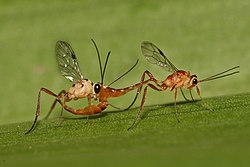| Cremastinae | |
|---|---|
 | |
 | |
| Cremastinae mating | |
| Scientific classification | |
| Domain: | Eukaryota |
| Kingdom: | Animalia |
| Phylum: | Arthropoda |
| Class: | Insecta |
| Order: | Hymenoptera |
| Family: | Ichneumonidae |
| Subfamily: | Cremastinae Förster, 1869 |
Cremastinae is a worldwide subfamily of the parasitic wasp family Ichneumonidae.
Contents
Cremastinae are koinobiont endoparasitoids of Lepidoptera; and sometimes, Coleoptera larvae in tunnels, leaf rolls, buds and galls.
Cremastines are usually slender and brightly colored wasps, though exceptions exist. [1] They are most commonly found in warm and dry habitats such as coastal areas or heathlands. [1]